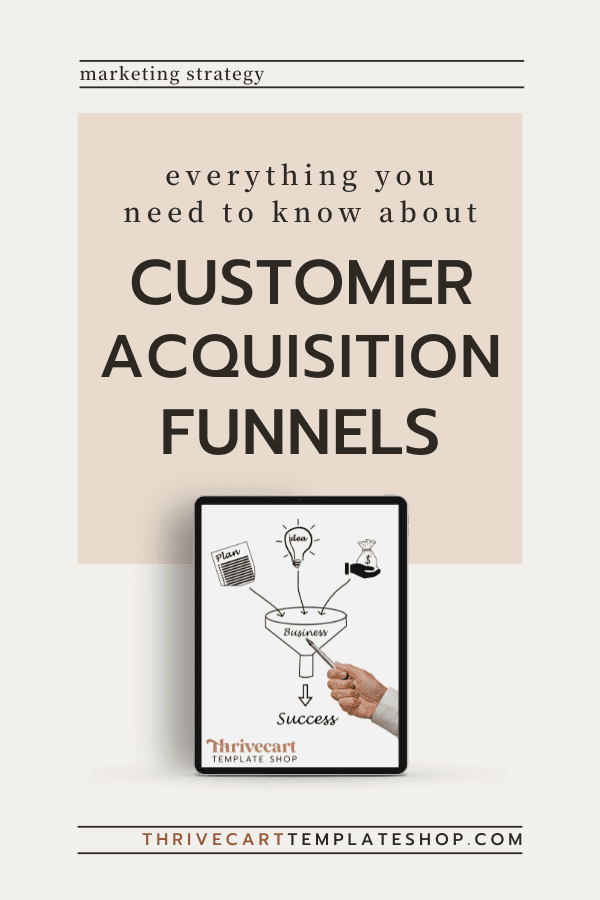

As a course creator or someone who sells digital products, you know that attracting new customers is key to the success of your business. But how do you go about doing it? One effective way is through a customer acquisition funnel.
In this post, we’ll cover everything you need to know about a customer acquisition funnel, including what it is, why it’s important, and how to create one that works for your business.
What is a Customer Acquisition Funnel?
A customer acquisition funnel, also known as a sales funnel, is a visual representation of the customer journey from initial awareness of your product or service (first hearing about it) to the point of purchase. It can also be called a ‘client acquisition funnel’.
The funnel is divided into stages, each representing a different step in the customer’s journey.
The most common stages of a customer acquisition funnel are:
- Awareness: The customer becomes aware of your product or service.
- Interest: The customer expresses interest in your product or service.
- Consideration: The customer considers purchasing your product or service.
- Conversion: The customer makes a purchase.
- Loyalty: The customer becomes a repeat customer and advocates for your brand.
Why is a Customer Acquisition Funnel Important for Course Creators and Digital Product Sellers?
A customer acquisition funnel is essential for any business that wants to attract and convert potential customers into paying customers. For course creators and digital product sellers, it is especially important because it helps you understand your customer’s journey and tailor your marketing efforts accordingly for the best results.
Without a customer acquisition funnel, you may be wasting time and resources on marketing efforts that aren’t effective in bringing in sales or aren’t reaching the right audience.
By understanding the different stages of the funnel, you can optimize your marketing efforts and increase your chances of converting potential customers into paying customers.
How to Create a Customer Acquisition Funnel
Creating a customer acquisition funnel involves several steps, including:
Define your target audience:
Before creating an effective customer acquisition funnel, you need to know your target audience – the ideal person to purchase your product. This will help you tailor your marketing efforts to their needs and interests, and speak directly to them. The more clear you get on your target audience – also known as your ideal client – the more effective your copy and positioning will be.
Map out your customer journey:
Once you have defined your target audience, you need to map out their journey through the funnel. This involves identifying the different touchpoints where your customer interacts with your brand and designing marketing efforts to move them through each stage of the funnel.
Create content and marketing materials:
With your customer journey mapped out, you can create content and marketing materials that are tailored to each stage of the funnel. For example, you may create blog posts or social media content to raise awareness of your product or email campaigns to convert potential customers into paying customers.
Optimize your funnel:
Once your funnel is up and running, you need to monitor its effectiveness and make adjustments as needed. This may involve tweaking your marketing efforts, adjusting your messaging, or optimizing your website for conversions.
Best Practices for Customer Acquisition Funnel Marketing
To get the most out of your customer acquisition funnel, it’s important to follow some best practices. Here are a few tips to keep in mind:
Focus on providing value: At each stage of the funnel, focus on providing value to your customer. This may involve offering free resources, answering questions, or giving personalized recommendations.
Use multiple channels: Don’t rely on just one marketing channel to reach your potential customers. Instead, use a combination of channels, such as social media, email marketing, and advertising, to reach a wider audience.
Measure your results: To know if your funnel is working, you need to measure your results. Use tools like Fathom Analytics and Drip to track your website traffic, conversions, and monitor your email marketing campaigns to see how many people are opening and clicking through your emails.
Final Thoughts
A customer acquisition funnel is a powerful tool for course creators and digital product sellers. By understanding your customer’s journey and tailoring your marketing efforts to each stage of the funnel, you can attract new customers and increase your revenue.
With the best practices outlined in this post, you’ll be well on your way to creating a successful customer acquisition funnel for your business.
And don’t forget, I have a free tripwire checklist to help you make money immediately in your customer acquisition funnel.

Other posts you may want to check out:
- ThriveCart and Encharge Integration Explained: Pros, Cons, and Real Talk
- What is a VSL Funnel & How to Build One in Thrivecart
- 6 Simple Ways to Improve Your Order Confirmation Page in Thrivecart
- Is Your Subscription Membership About To Violate Federal Law?
- Recurring Revenue Businesses: The Pros and Cons of This Business Model